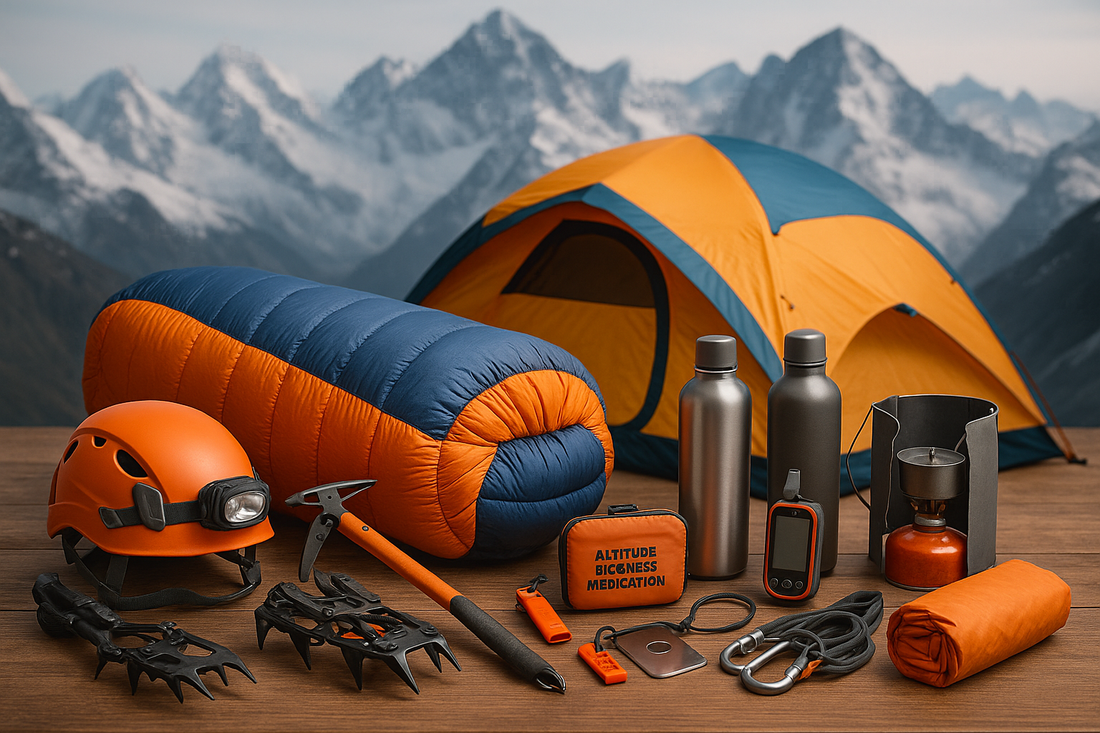
High-Altitude Camping Gear for Safety
Share
Camping in the mountains is one of the most rewarding adventures you can experience. The views are breathtaking, the air is crisp, and the sense of accomplishment is unmatched. But there’s a catch—high-altitude camping also comes with unique risks. The higher you go, the thinner the air, the colder the nights, and the more unpredictable the weather. Without the right safety gear, what should be a thrilling adventure can quickly become dangerous.
To help you stay safe and prepared, here’s a complete list of essential high-altitude camping gear that every mountain adventurer should pack.
1. Oxygen & Breathing Support
At altitudes above 8,000 feet, the reduced oxygen can trigger altitude sickness—headaches, dizziness, nausea, and even more serious conditions. Carrying the right gear can make all the difference.
-
Portable Oxygen Canisters – Great for emergencies when breathing becomes difficult.
-
Pulse Oximeter – A small device that clips to your finger to track oxygen saturation levels.
-
Nasal Strips or Breathing Aids – Help open airways for better sleep at high altitudes.
👉 Tip: Always ascend gradually when possible. Gear helps, but your body needs time to adapt.
2. Sleeping Gear for Extreme Cold
High-altitude nights are brutally cold, even in summer. Staying warm is critical for both comfort and survival.
-
Four-Season Tent – Built to handle strong winds, heavy snow, and freezing temps.
-
Sub-Zero Sleeping Bag – Choose a bag rated at least -20°F (-29°C) for winter conditions.
-
Insulated Sleeping Pad – Prevents body heat from escaping into the frozen ground.
-
Emergency Bivy Sack – Lightweight backup shelter in case of tent failure.
3. Clothing & Layering System
The golden rule of mountain camping: layering is survival. Weather can change in minutes, so flexibility is key.
-
Moisture-Wicking Base Layer – Keeps sweat off your skin.
-
Insulated Jacket (Down or Synthetic) – Traps heat without bulk.
-
Shell Jacket & Pants – Windproof, waterproof, and breathable.
-
Accessories – Thermal gloves, balaclava, and insulated socks to protect extremities.
👉 Remember: Never wear cotton at high altitudes. Once wet, it drains heat from your body.
4. Hydration & Nutrition Gear
Dehydration is a common cause of altitude sickness. Cold weather also makes people forget to drink water.
-
Insulated Water Bottles – Prevent your water from freezing overnight.
-
Portable Water Filters – Essential for drinking from streams or glacier runoff.
-
Electrolyte Packets – Restore minerals lost through exertion.
-
High-Calorie Food – Energy bars, nuts, and freeze-dried meals keep you fueled.
5. Navigation & Safety Tech
Mountain terrain is often unpredictable, and cell service is unreliable at best. Navigation and communication gear can be lifesaving.
-
GPS Device or Offline Maps – Download maps before your trip.
-
Satellite Messenger or PLB (Personal Locator Beacon) – Lets you send SOS signals even without cell coverage.
-
Headlamp with Extra Batteries – Reliable light source for night hikes or emergencies.
6. First Aid & Emergency Gear
Accidents can happen anytime, and medical help may be hours (or days) away.
-
Altitude Sickness Medication – Acetazolamide (Diamox) or ibuprofen (consult a doctor before use).
-
First Aid Kit – Include bandages, blister care, pain relievers, and antiseptic wipes.
-
Fire-Starting Tools – Waterproof matches, lighters, or ferro rods.
-
Compact Emergency Shelter – Reflective blankets or tarps for unexpected conditions.
7. Footwear & Trekking Gear
Your feet are your lifeline in the mountains—choose gear that protects them.
-
Mountaineering Boots – Insulated, waterproof, and designed for rocky or icy terrain.
-
Microspikes or Crampons – For icy trails and steep ascents.
-
Trekking Poles – Improve balance and reduce knee strain.
Final Thoughts
High-altitude camping is not just another weekend in the woods—it’s a true adventure that demands preparation. The right gear can mean the difference between a safe, unforgettable trip and a dangerous situation.
When planning your next mountain expedition, focus on:
-
Breathing support gear for altitude sickness.
-
Cold-weather sleeping gear for safety at night.
-
Layered clothing and footwear designed for extreme conditions.
-
Emergency and navigation gear that keeps you prepared for the unexpected.
Pack smart, respect the mountains, and remember: prepare for the worst so you can enjoy the best views. 🏔️
